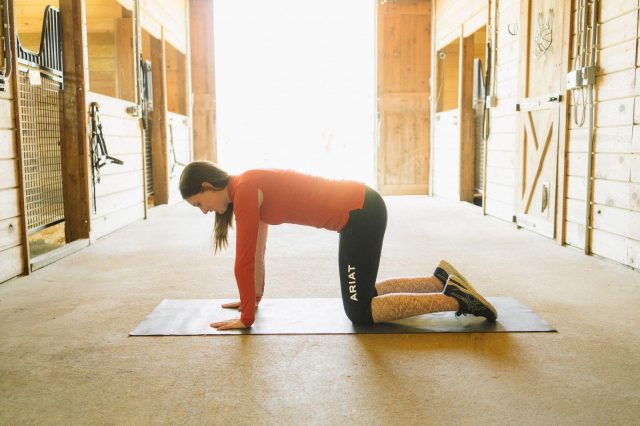
One Simple Fitness Exercise to Help You Sit the Trot Like a Grand Prix Rider
Should dressage riders and eventers have different workout regimes? That’s the question on the table today – plus, here’s an exercise to help all riders build strength and stability through the seat:

Want to sit the trot so well you start firing out sub-20 scores? Laura’s got the exercise for you. Photo by Shelby Allen.
A good friend of mine recently made the shift from mostly eventing to mostly dressage. The first questions she postulated for me were, ‘what does this mean for my exercise routine?’ and, ‘do you think that there is an exercise that I should be doing more now that I’m a dressage rider?’ The answer to both of those questions, though, goes much deeper than a simple ‘yes’ or ‘no’.
My first question in response to something like this is always this: Are you exercising outside of the tack? If you are exercising, I’m proud of you: that’s half the battle, and one where a lot of equestrians fall short already. In my book Ultimate Exercise Routines for Riders there are event riders, jumper riders, and dressage riders as models. However, the routines aren’t specific for the discipline they represent. A dressage rider can get as much out of the Sharon White exercise routine as the showjumper can get from the routine with Lauren Sprieser.
I work with many event riders because, to be honest with you, this is the population I know best. However, I also train professional dressage rider JJ Tate, and have worked with many professional and amateur dressage riders. The exercises I have JJ doing aren’t all the same as the ones I prescribe to my event riders — however, there is also a lot of overlap, and very rarely will any rider get through of a week without doing squats or bird dogs.
Here’s something that’s totally universal for riders of all disciplines, though: the best muscle to target if you want to develop an independent seat is the glute medius. I will say, of course, that most strictly dressage riders are already pretty strong in area of the body — however, the event rider tends to be a lot stronger in the hip adductors or the inner thigh. This comes from establishing a strong galloping position.
But what about those eventers who want to develop their seat to emulate the strength of dressage riders? A great exercise for transitioning from eventing to dressage is the fire hydrant, but this is also a great exercise for the strictly event rider to do as well, because it’s main focus is developing your glute medius. This exercise will help you to wrap your leg around the horse in the sitting trot and canter transitions, and it’ll also help with applying your leg correctly — a win all round!
The Fire Hydrant

To begin the exercise, start on all fours. Photo by Tally Ho Creative.
1. Start on all fours, with your hands under your shoulders and you knees aligned under your hips.

Begin to lift your knee while keeping your spine straight. Photo by Tally Ho Creative.
2. Keeping your hands rooted into the ground, lift your knee off the ground.

Here’s an example of what it looks like when you let your spine rotate – don’t do this! Photo by Tally Ho Creative.
3. While staying strong in your spine (you don’t want too much rotation in your spine, so focus on staying straight), lift your leg to the side with your knee bent.

Instead, stay straight, move slowly and deliberately, and focus on your breathing, too, rather than quick fire reps. Photo by Tally Ho Creative.
4. Inhale as you bring it up, exhale as you bring it back down.
5. Repeat for two minutes or as long as you can, and then switch and do the other side.
Laura Crump Anderson is a certified as a personal trainer by the American College of Sports Medicine and is a Registered 200 Hour Teacher with the Yoga Alliance. She specializes in working with riders of all ages and disciplines through her business, Hidden Heights Fitness, and is also the author of Ultimate Exercise Routines for Riders. She holds a Bachelor’s of Science in Kinesiology with a concentration in Exercise Science, and has evented through Training level. You can read more of her fitness columns on our sister site, Eventing Nation.





